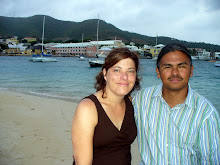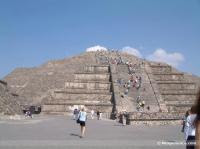The Valley of Oaxaca is a haven for all types of art and craft forms. On Monday we visited a couple of villages, each specializing in their own craft. Our first stop was San Martin Tilcajete, south of the city.

As we got out of our car, we heard clanking bells and then saw several groups of young men with body paint and masks running around and yelling. They approached the school we were parked next to – kids were outside apparently during recess – tried to scare them. The kids loved it! My kids were intrigued, except Rafael, who was afraid. The men were celebrating Carnaval.

San Martine Tilcajete is home to a number of wood carvers. Although wood carving has a long tradition in Oaxaca, the recent popularity of the carvings has affected the folk art form. These days everything from fanciful creatures, to life-like animals, to frames, boxes and miniature tables and chairs are carved.

Synthetic paints are frequently used, and the carvings, also known as alebrijes, are very bright and fun. We entered several different workshops along the street and talked to a few artisans.

Typically, wood from the copal tree, which is readily found in Oaxaca, is used for carvings although some carvers are branching out.

The carving is done while the branches are still green, and then left to dry for months until it’s time to paint. We enjoyed our tour of the workshops and bought a few alebrijes to bring home.

Our next stop was San Bartolo Coyotepec, famed for its black pottery. We had lunch and then let the kids play on a one of the only playgrounds we’ve seen during our trip. They really enjoyed it!

Next we walked around the little town, which is decorated with enormous black pots. The church, above, was closed (much to the kids’ relief!). The pottery is all hand made – no wheels or modern tools are used. We enjoyed our visit here, but were disappointed that the village’s craft museum was closed.
 As we got out of our car, we heard clanking bells and then saw several groups of young men with body paint and masks running around and yelling. They approached the school we were parked next to – kids were outside apparently during recess – tried to scare them. The kids loved it! My kids were intrigued, except Rafael, who was afraid. The men were celebrating Carnaval.
As we got out of our car, we heard clanking bells and then saw several groups of young men with body paint and masks running around and yelling. They approached the school we were parked next to – kids were outside apparently during recess – tried to scare them. The kids loved it! My kids were intrigued, except Rafael, who was afraid. The men were celebrating Carnaval. San Martine Tilcajete is home to a number of wood carvers. Although wood carving has a long tradition in Oaxaca, the recent popularity of the carvings has affected the folk art form. These days everything from fanciful creatures, to life-like animals, to frames, boxes and miniature tables and chairs are carved.
San Martine Tilcajete is home to a number of wood carvers. Although wood carving has a long tradition in Oaxaca, the recent popularity of the carvings has affected the folk art form. These days everything from fanciful creatures, to life-like animals, to frames, boxes and miniature tables and chairs are carved. Synthetic paints are frequently used, and the carvings, also known as alebrijes, are very bright and fun. We entered several different workshops along the street and talked to a few artisans.
Synthetic paints are frequently used, and the carvings, also known as alebrijes, are very bright and fun. We entered several different workshops along the street and talked to a few artisans. Typically, wood from the copal tree, which is readily found in Oaxaca, is used for carvings although some carvers are branching out.
Typically, wood from the copal tree, which is readily found in Oaxaca, is used for carvings although some carvers are branching out.  The carving is done while the branches are still green, and then left to dry for months until it’s time to paint. We enjoyed our tour of the workshops and bought a few alebrijes to bring home.
The carving is done while the branches are still green, and then left to dry for months until it’s time to paint. We enjoyed our tour of the workshops and bought a few alebrijes to bring home. Our next stop was San Bartolo Coyotepec, famed for its black pottery. We had lunch and then let the kids play on a one of the only playgrounds we’ve seen during our trip. They really enjoyed it!
Our next stop was San Bartolo Coyotepec, famed for its black pottery. We had lunch and then let the kids play on a one of the only playgrounds we’ve seen during our trip. They really enjoyed it! Next we walked around the little town, which is decorated with enormous black pots. The church, above, was closed (much to the kids’ relief!). The pottery is all hand made – no wheels or modern tools are used. We enjoyed our visit here, but were disappointed that the village’s craft museum was closed.
Next we walked around the little town, which is decorated with enormous black pots. The church, above, was closed (much to the kids’ relief!). The pottery is all hand made – no wheels or modern tools are used. We enjoyed our visit here, but were disappointed that the village’s craft museum was closed. 




No comments:
Post a Comment